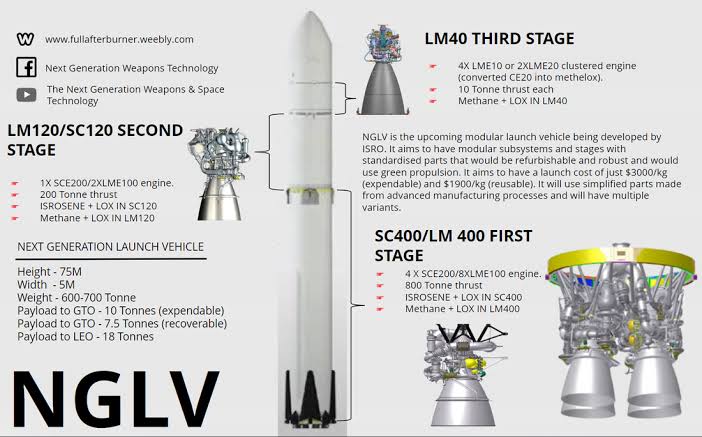ISRO 30-Ton NGLV future launch vehicle

The Next Generation Launch Vehicle of ISRO represents a major leap forward for India’s space ambitions, enhancing capabilities while promoting cost efficiency and sustainability in space operations.
The Indian Space Research Organisation (ISRO) is going ahead with the development of the Next Generation Launch Vehicle (NGLV).
Shri V Narayanan, the ISRO Chairman, gives key insights into this ambitious project.
The NGLV is designed to carry a maximum payload of 30 tons to Low Earth Orbit (LEO), which is three times the current capability of existing rockets like the LVM3, while operating at 1.5 times the cost.
This 1,000-ton lift-off mass vehicle will stand 93 meters tall and feature three stages, supported by two solid strap-on boosters, each with 190 tons of propellant.
The first stage will be powered by nine engines, each producing 110 tons of thrust with a propellant load of 475 tons.
The second stage will feature two engines, while the upper C32 cryogenic stage will use liquid oxygen and liquid hydrogen propellant combination,” Narayanan explained, adding that the next-generation launch vehicle represents a major leap in ISRO’s space exploration capabilities.
A standout feature of the NGLV is its reusable first stage, which is expected to lower launch costs significantly. Estimates suggest a target cost of approximately $1,900 per kg for reusable configurations compared to $3,000 per kg for expendable models.
On January 16, 2025, the Union Cabinet, led by Prime Minister Narendra Modi, approved the establishment of a third launch pad (TLP) at ISRO’s Satish Dhawan Space Centre in Sriharikota, Andhra Pradesh.
This decision supports India’s space exploration goals, including establishing the Bharatiya Antriksh Station (BAS) and achieving an Indian crewed lunar landing by 2040. The new TLP will also facilitate the development of the Next Generation Launch Vehicle (NGLV).
The project is estimated to cost ₹3,984.8 crore, which includes the establishment of the launch pad and associated facilities.
The project is slated to be completed within 48 monthsThe NGLV is part of ISRO’s broader vision to establish the Bharatiya Antariksh Station and support human spaceflight missions by 2040.
It will facilitate various national and commercial missions, including lunar and interplanetary exploration, as well as launching satellite constellations for communication and earth observation.
S. Sivakumar is the Program Director for ISRO’s Space Transportation System and the Project Director for the Next Generation Launch Vehicle (NGLV) at the Vikram Sarabhai Space Centre (VSSC).
He is overseeing an 8-year development plan for the NGLV, which is scheduled to be completed by December 2032. The NGLV project is internally named SOORYA.
Sivakumar has emphasised the challenges involved, noting that creating space habitats and achieving lunar landings will require new systems and vehicle configurations.
His goal is to establish a cost-effective and reliable space transportation system for various payloads, including cargo, humans, and scientific experiments.
The project has been allocated a budget of ₹8,240 crores, covering development costs, three developmental flights (D1, D2, and D3), and essential infrastructure.
The development phase is targeted to be completed in 96 months (8 years), with initial flights planned as early as 2031 and the first launch tentatively scheduled for 2034-35.
India has already achieved self-reliance in space transportation systems, enabling the launch of satellites up to 10 tons to Low Earth Orbit (LEO) and 4 tonnes to Geo-Synchronous Transfer Orbit (GTO).
This is accomplished through the use of currently operational launch vehicles, including PSLV, GSLV, LVM3, and SSLV.
The development of the Next Generation Launch Vehicle (NGLV) is expected to further enhance India’s space launch capabilities. The NGLV is designed to have a maximum payload capability of 30 tonnes to LEO and will incorporate reusability features for more affordable access to space.
The Indian government has approved ₹8,240 crore for the NGLV’s development, which includes three developmental flights, infrastructure, and program management.
The NGLV will support national and commercial missions, including human spaceflight, lunar and interplanetary exploration, and the deployment of satellite constellations.
ISRO plans to engage extensively with the private sector to bolster manufacturing capabilities and operational support for the NGLV.
This collaboration aims to foster a robust domestic aerospace industry that can meet growing demands in space exploration and satellite deployment.




